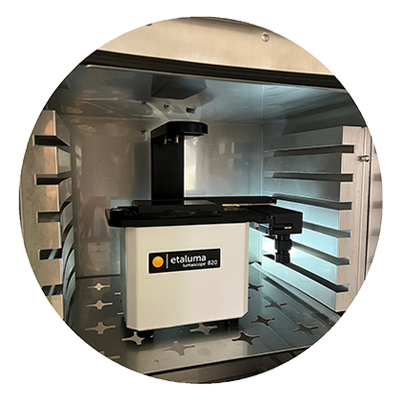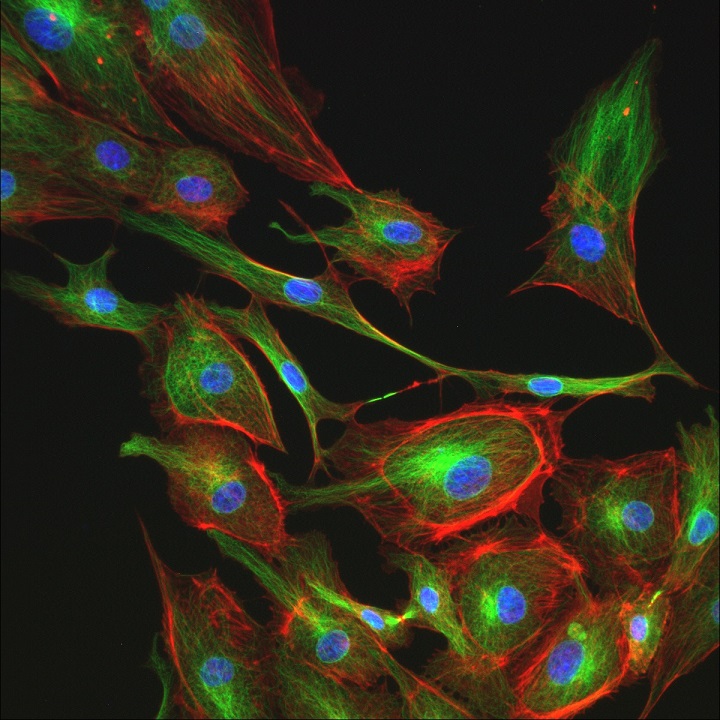A Dramatic New Concept in
High Resolution, Inverted Fluorescence Microscopy
Lumascopes are highly versatile, compact inverted fluorescence microscopes that provides high resolution images comparable to those from traditional, high-cost microscopes. The Lumascope design was conceived and developed by working scientists who realized that a large proportion of everyday fluorescence microscopy involves imaging and measuring the presence, health, and signal of labeled cells. Traditional inverted microscopes are expensive, complicated, and loaded with features that are not required for these tasks. Lumascopes focus on: quality images, versatility, compact design, ease of use, and amazingly low price.
Lumascopes utilize LED light sources, Semrock filters, advanced optical engineering, and CMOS sensors to provide near diffraction-limited (theoretical maximum) resolution. Powered only by a USB connection, Lumascopes easily record your photos, time-lapse series, and live videos directly to your computer. And their compact size enable working in challenging locations, including inside incubators, biological safety cabinets, and environmental control workstations with remote control and image monitoring.
The inverted design accommodates microplates, flasks, dishes and custom labware in addition to slides that you can adjust by the Manual XY Stage (on the LS820,) or control manually or automatically on the automated LS850. Lumascopes come with LumaviewPro software that sends images directly to your computer via a USB cable, eliminating the need for on-board image storage and processing and contributing to the compact size. LumaviewPro enables time-lapse studies over seconds, minutes, hours, or days. Live videos can be recorded at up to 30 frames per second.
Lumascopes Can Be Used in Many Applications

Compact design allows use inside incubators, hoods, and workstations.
- Live cell imaging
- Cell growth and confluence
- Cell migration and wound healing
- Determining transfection efficiency
- Tracking and quantifying protein expression
- Following cell differentiation
- High Content Analysis
- Intravital studies
- Photomicroscopy in locations without AC power
See Applications for additional examples and results.
| Comparison of Lumascope Models | ||
|---|---|---|
| Features | LS820 | LS850 |
| Optics | Blue, green & red fluorescence; bright field | Blue, green & red fluorescence; bright field |
| Phase Contrast | Phase contrast optional (Auraphase) | Phase contrast optional (Auraphase) |
| Objective Options | 1.25x,2.5x, 4x, 10x, 20x, 40x, 60x, and 100x(oil) magnification | 1.25x,2.5x, 4x, 10x, 20x, 40x, 60x, and 100x(oil) magnification |
| Objective Compatibilities | RMS-threaded, infinity corrected, 45 mm parfocal distance | RMS-threaded, infinity corrected, 45 mm parfocal distance |
| Fluorescence Filters | Blue: Ex 370-410, Em 429-462 nm; Green: Ex 473-491, Em 502-561 nm; Red: Ex 580-598, Em 612-680 nm | Blue: Ex 370-410, Em 429-462 nm; Green: Ex 473-491, Em 502-561 nm; Red: Ex 580-598, Em 612-680 nm |
| Camera | High QE Monochrome CMOS BSI Sensor; 4.4 Megapixel, 12-Bit | High QE Monochrome CMOS BSI Sensor; 4.4 Megapixel, 12-Bit |
| Image Formats | JPG, BMP, TIF, or PNG | JPG, BMP, TIF, or PNG |
| Image Size | 100x100 to 2100x2100 pixels | 100x100 to 2100x2100 pixels |
| Field of View | Up to 0.78 x 0.78 mm at 20x | Up to 0.78 x 0.78 mm at 20x |
| Video Rates | 45 fps (exposure limited) | 45 fps (exposure limited) |
| Stage | Manual XY | Automated XY, 110 mm X 74mm, 1-3 micron positional reproducibility |
| Motorized Z | 14mm travel, 100nm step, image-based autofocus, Z-stacks | 14mm travel, 100nm step, image-based autofocus, Z-stacks |
| Well-to-well time (seconds) | NA | Image 96 wells: under 2 minutes with 1 channel, no auto-focus |
| Control Software | LumaviewPro | LumaviewPro |
| Computer Requirements | Windows 10, 11; Core i7, SSD | Windows 10, 11; Core i7, 1 TB SSD, 8 GM RAM |
| Integration | Python Source under the MIT Open Source License | Python Source under the MIT Open Source License |
| Power Requirements | USB3 for LS; 100-240 V, 50-60 Hz for autostage | USB3 for LS; 100-240 V, 50-60 Hz for autostage |
| Dimensions (WxDxH) | 24cm W x 22.6cm D x 27.8cm H (9.4in W x 8.9in D x 10.9in H) | 39.8cm W x 29.7cm D x 29.7cm H (15.6in W x 11.6in D x 11.6in H) |
| Weight | 5 kg (10 lb) | 9.5 kg (21 lb) |
| Operating Conditions | 0°C - 42°C, 5% - 95% RH non-condensing | 0°C - 42°C, 5% - 95% RH non-condensing |
Copyright © 2024 Etaluma, Inc. All rights reserved.

